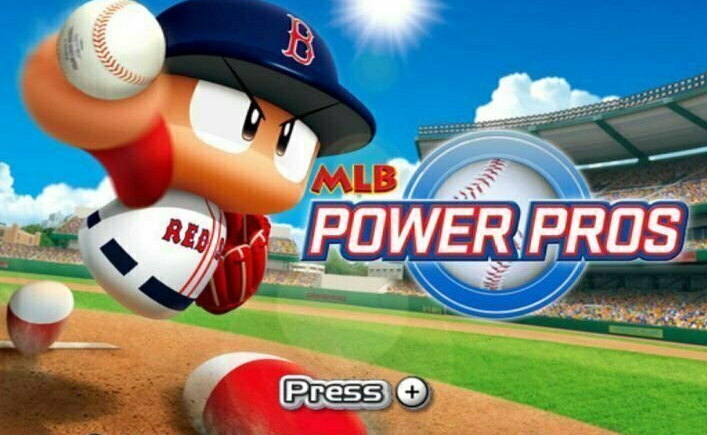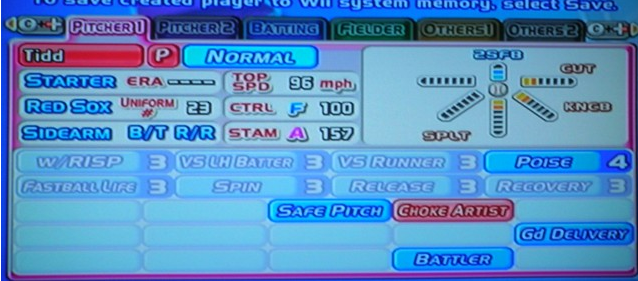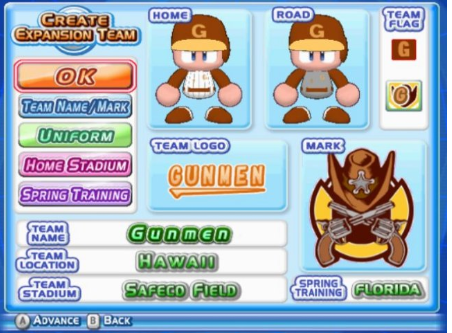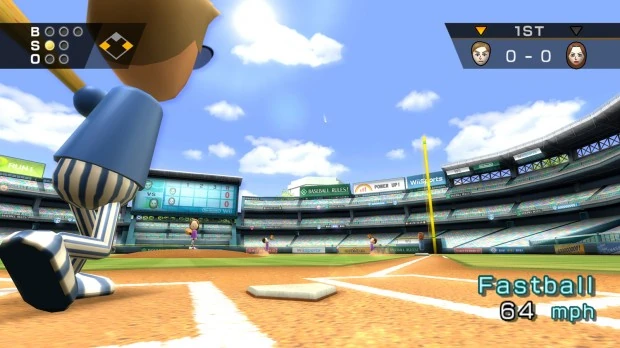[polldaddy poll=10472272]
I have this distinct memory of playing NBA Live 07 on the GameCube shortly after it had come out, of my dad saying, “I can’t believe how real video games look nowadays.” He would continue to marvel at the increasingly photorealistic graphics that sports games would churn out year after year, even asking me one time as I was playing NBA 2K11 if I was watching a real game on TV. Once 3D graphics became a thing in the late 90s, gaming companies continued to push themselves to try and blur the line between video game graphics and reality. Of course, sometimes games would come out where they threw all that out the door and said, “Let’s just get cute with it.” That’s where we find ourselves today, with MLB Power Pros and Wii Sports.
MLB Power Pros (2007/2008)

Beneath its cutesy exterior, MLB Power Pros beats the heart of a challenging, complex, and thoroughly entertaining baseball simulator.
Gameplay: Don’t let the charming sprites or two-button action fool you—this is one of, if not the deepest console baseball games I’ve ever played. It was a collaboration between Konami and 2K Sports and has been a long-running series across the Pacific. They’ve done a splendid job creating an experience that has incredible depth while also being easy to pick up and play. This American version of the game was made for the Nintendo Wii, and the baseball games themselves are pretty simple to play out. To pitch, you hold one direction on the control pad that corresponds to the pitch you’d like to throw, use the control stick to set the location, and press/hold a button to deliver the pitch (the longer you hold it, the harder you throw it). To hit, you use the control stick to line up where you want your bat to go through the strike zone and press a button to swing. You can also hold a direction on the control pad to try and pull or go the other way. To field, you use the control stick to run after a ball and push a button to throw it. It’ll throw to whatever base the computer thinks is best, but you can override it by holding down a direction on the control pad. If you’ve ever played any type of video game baseball, you know how to play a basic game of Power Pros.
So why do I say it’s complex? Because there’s so, SO much more. In addition to giving players a letter grade for various skills (Power, Contact, Control, etc.) that impacts how well they perform, they also baked in nearly 100 abilities players can earn. These abilities change the player’s performance in various situations. For example, a hitter that has the “Table Setter” ability gets a contact boost whenever they’re up with nobody on. A pitcher with the “Good Delivery” ability always uses the same arm slot and delivery when throwing different types of pitches. An outfielder with the “Cannon Arm” ability allows him to skip the cutoff man while also making their throws lower and harder than normal. Some abilities are more complex, like “Battler”, which makes a pitcher immune to the “Intimidator” ability some hitter have, increases their poise (yes, they have that in the game too), reduces all opposing hitters’ power grade slightly, and has the pitcher do a fist pump when they get the final out of an inning—but it only turns on when you’ve allowed two or fewer runs in the game, you’re not losing, and your pitcher isn’t fatigued or already rattled. There are over 100, with plenty more complex abilities (like “Choke Artist” which decreases movement and velocity for pitchers who are in line to get the win in the 5th inning or when closing out the final inning), negative abilities (like Free Swinger, which greatly reduces contact ability with two strikes), and even abilities that have up to five levels (like “Fastball Life”, “2nd Position”, and “Clutch Hit”).

(Here is a screenshot of how the player’s ability card looks, and yes, each of those blank rectangles could theoretically hold a skill)
In addition to abilities, they included a ton of different stances and swings that were instantly recognizable, as well as 25 different pitches. The various pitches were probably my favorite to play around with. I mean, who wouldn’t want a guy who can throw a four seamer at 95, a screwball at 79, a shuuto at 87 (like a slider but in the opposite direction), AND a knuckle curve at 83? And then, just for giggles, how about a 71 mph knuckleball mixed in? It’s just filthy!
Players can even gain or lose abilities, pitches, and skill level in some of the game modes you play. The one I probably played most was probably Season Mode, which is essentially the franchise mode of the game. You got to play up to 10 seasons while managing the salary cap, signing free agents, and putting players through Spring Training. You could either take over an existing team or do “Expansion Mode” that added two more teams to the league that you create (choosing a logo, colors, location, etc.). You could also do a fantasy draft mode. There wasn’t a ton in the way of minor leagues, but with the depth of players and abilities available, as well as the improvement and degradation of skills with age, there was all the action you’d need to enjoy the game.

(Creating teams was actually pretty entertaining and satisfying in this game)
Success Mode was something unique to the game that I also enjoyed. Essentially, it was a mini RPG/simulator that took a player you create through college as you tried to make an impression and make it to the minor leagues. You would have multiple mini games to play, conversations to have with your buddy Marvin, a possible love interest, a part-time job, and other various things to deal with. You often had to choose your own adventure in the conversation options using your “Fate Cards”, which added an interesting element to the game. You might have to say “No” in a place you don’t really want to because you need to hold your “Yes” card for something more important later, for example. It was strangely enchanting to play through. You also get the standard goodies, like choosing from a huge variety of batting stances and deliveries and spreading out your skill points to craft the type of player you want to be. Based on your actions and dialogue choices in the story, you can also gain abilities.
Finally, there was also an Exhibition Mode, which is exactly what it sounds like, a Home Run Derby mode that was basically Wii Sports Baseball (SO HOW COULD THAT POSSIBLY WIN THIS ROUND?), and a Wii Remote mode that was like a mix of Exhibition and Home Run Derby.
Finally, the game kept meticulous stats of your own performance. I looked up that I hit just above .400 on high fastballs when batting with a righty, for example. I also hit almost .100 on circle changeups down and in from a righty as a righty because I like to swing and those are basically unhittable. That’s fun. Wholesome, nerdy fun.
Replayability: Success Mode and Season Mode offered quite a bit of replayability in a fairly obvious way. Want to make new players? Run through Success Mode again. They also had unlockable events and skills through Success Mode that were fun to gather. Season Mode was also fairly replayable, though I eventually figured out the various formulas to becoming a juggernaut by the second or third year. After that point, I started using Expansion Mode within the Season Mode, as the team you take over is…not very good. That added a nice layer of challenge to the game.
Graphics: The Wii was not a graphics powerhouse, so I think Power Pros was smart to use very simplistic “chibi” versions of players. Here are four players in the game, all active in the mid-2000’s. They don’t have arms, legs, noses, mouths, or fingers, but I bet you can guess who they are.

(From top-left to bottom-right: Kevin Youkilis, Manny Ramirez, Carlos Zambrano, Ichiro Suzuki)
These graphics are charming, but they’re drastically different from the realistic graphics of modern American baseball video games. I appreciate the simplicity, but won’t try to argue that they’re “better”. I mean, they’re better than Miis, but other than that it’s personal preference. They also did a great job with nuance. Unique batting stances and deliveries are all part of the gamer, from Dontrelle Willis’s crazy delivery to Gary Sheffield’s infamous bat waggle. In the image above, you can even see Ichiro’s classic pre-batting ritual, which was followed by his closed stance that made it seem like he was falling towards first with every swing.
Sound: Not much to this category for this game. Basic sounds work well, has generic video game music most of the time, and other than some very basic announcing, there’s no speech.
Miscellaneous: I probably said everything that needs to be said for this game in the Gameplay section. This is the Japanese equivalent to RBI Baseball that has cuter, simpler packaging but all of the depth and nuance. It’s probably miscast here in the “Casual Fun” bracket, even though it has that appearance and is very much a pick up and play title as far as exhibition goes, as the catalog of pitches and abilities don’t really need to be understood to play a basic exhibition game. That said, they added so many wonderful layers to this game that I kept playing this for close to seven years before my Wii finally crapped out about five years ago. RIP.
-Scott Chu
Wii Sports (2006)

In stark contrast to MLB Power Pros, the cute and simple exterior of Wii Sports baseball is entirely indicative of what you’re getting, which makes sense, given that rather than being a full game like every other game we’ve reviewed in this series, Wii Sports baseball is merely 1/5 of the total Wii Sports package.
Gameplay: The modus operandi for all of Wii Sports was to boil down their respective sports to their most basic elements, in order to make them as easy to learn, and thus as easy to play as possible for everyone, from young children to grandparents to Conan O’Brien. Thus, Wii baseball is controlled almost exclusively with just a flick of the wrist. The only means of controlling your Mii avatar at the bat is swinging the Wii remote at the correct time to hit the ball as far as possible. There’s some slight nuance to it, by sticking out your remote and holding it still you’re effectively able to bunt, and you can adjust the angle at which you swing to pop the ball up or drive it down, but that’s about it. Baserunning is handled entirely by the computer, as is defense. Pitching is slightly more involved, as in addition to swinging the remote to throw your pitch, you can choose between four different pitches (Press A for a screwball, B for a curveball, A+B for a splitter, and nothing for a fastball) and adjust the location of your pitch by pressing the desired location on the directional pad. You can also press the 2 button to throw a pitch sidearm, rather than overhand. The addition of pitch variety does a lot to make the game feel less like simply swinging the Wii remote mindlessly (looking at you, boxing), while a player who doesn’t want to do these is able to skip over them, and can still win games. That’s really it for the gameplay, swing, pitch, repeat until your three inning game is done. The simplicity of the controls and the three inning limit makes games remarkably fast, perfect for Wii Sports’ party game-esque approach.
Replayability: The short, simple games do wonders for the replayability. The minimal effort required combine with how many games you’re able to crank out in a relatively short time means it takes a while for burnout to set in, and I could probably play this game for a full day with a group of buddies. The lack of control over most elements of the game in comparison to other baseball games means that while skill is definitely a factor, it’s far easier for someone who just picked the game up for the first time to beat a seasoned vet than in any other sports gamer I’ve played, with the possible exception of NBA Jam. If you’re like nine year-old Nate though and have no friends to trash talk over a game of baseball, the single-player “campaign” that pits you against harder and harder opponents is a satisfying way to kill time, though I can’t imagine doing it more than just once or twice through.
Graphics: If you played basically any game on the Wii with multiplayer elements of any kind, you’re more than familiar with Mii’s. Love or hate the customizable avatars that look like a matryoshka doll and a Nendoroid were crossbred, you can’t deny how iconic they are. The simplicity of the Mii’s matches the gameplay and other presentation here, and I think that a lot of the charm here would have been lost had Nintendo opted to use Mario characters, for example. Everything else here is par for the course for an early Wii game. It’s pleasant enough to look at, and that’s what matters at the end of the day. Even 13 years after it’s release, Wii Sports still more or less holds up visually.
Sound: Rinse and repeat the graphics section. The sound design is simple, but works perfectly for the game. The subdued crowd noise works well in place of background music, though it’s a shame this funky, funky track was relegated to the baseball training mode. The sound effects are crisp and satisfying, from the zooming sound of a fastball coming down the pipe to the sharp crack of a home run. Though the amount of voice lines is small compared to most baseball games, the announcer’s voice is fun and oh so iconic. I wish I had more to talk about here, but those couple sentences genuinely cover the entirety of the sound design.
Miscellaneous: I’ve pretty much covered everything this game has to offer in the previous sections. I’ll instead use this time to spread the good word: Wii Sports boxing is genuinely terrible, and a black mark on Shigeru Miyamoto and Kazumi Totaka’s entire legendary careers. Thank you for coming to my TED Talk.
-Nate Watt
Featured Image by Justin Paradis (@freshmeatcomm on Twitter)
